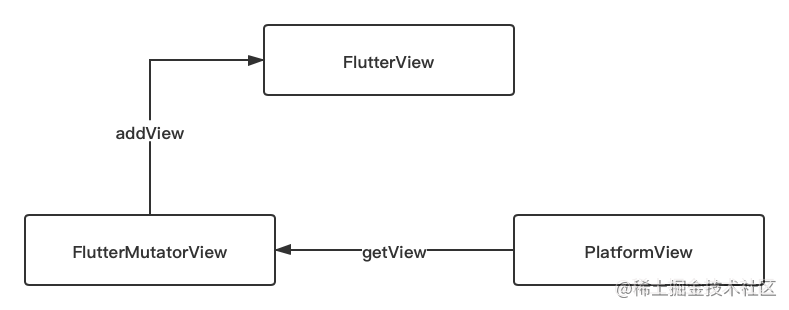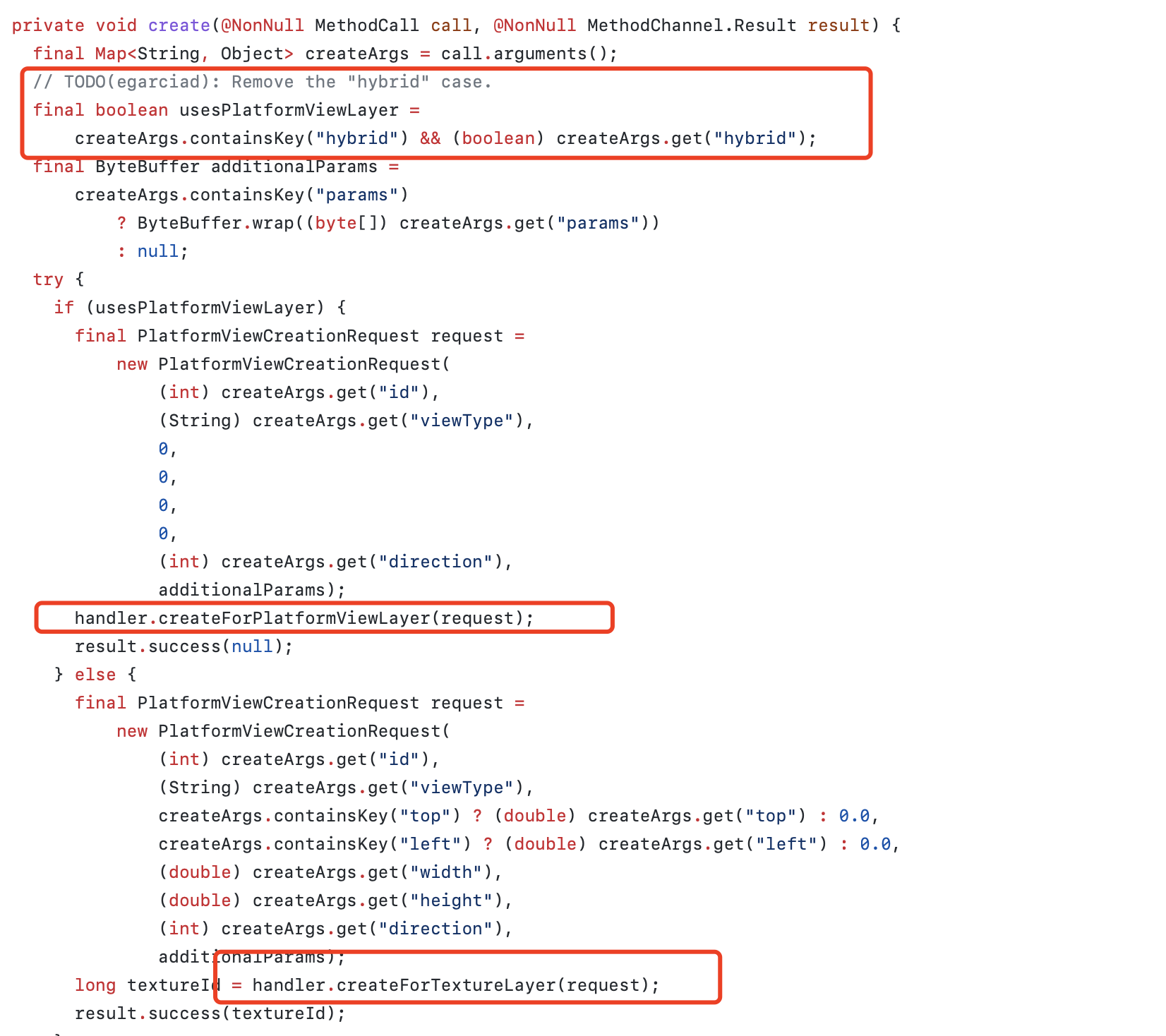Fluttter 混合开发下 HybridComposition 和 VirtualDisplay 的实现与未来演进
对于使用过 Flutter 的开发来说,应该对在 Flutter 混合开发中,通过 PlatformView 接入原生控件的方式并不陌生,而如果你是从 Flutter 1.20 之前就开始使用 Flutter ,那么应该对于 Android 上 PlatformView 的各种体验问题有过深刻的体会,比如: WebView 里弹出键盘的问题。
⚠️注意:文末有惊喜
从一个问题开始
恰巧最近一位朋友在 Flutter 2.10.1 上使用 webview_flutter 和 flutter_pdfview 测试时出现了如下的问题:
attachToContext: GLConsumer is already attached to a context at android.graphics.SurfaceTexture.attachToGLContext(SurfaceTexture.java:289)
- 1
所以借着这个问题来给大家科普下 Flutter 里 PlatformView 实现的变迁和未来调整,首先这个问题的起因是因为:
virtual displayes 和 hybrid composition 两种
PlatformView实现混合使用。
因为从 Flutter 2.10 开始,官方的 Plugin 如 webview_flutter 默都是使用 hybrid composition 的实现,而第三方的 flutter_pdfview 目前还是使用以前的 virtual display ,这就出现了两种 PlatformView 实现同时出现的情况。
当然,官方在 2.10.2 版本的 #31390 上修复了这个问题, 问题的原因在于:当 rasterizer 任务运行不同的线程时,GrContext 会被重新创建,从而导致 texture 变成没有初始化的状态,进而重复调用 attachToGLContext 导致崩溃。
所以后续官方修复这个问题,就是在
attachToGLContext之前,如果texture已经 attach 过,就先调用detachFromGLContext进行释放,从而避免了初始化 context 的问题。
但是从问题上看,其实这个问题并不是 2.10 才会出现,而是只要在 SurfaceTextureWrapper 这个对象存在时 ,混合使用 virtual displayes 和 hybrid composition 就能引发这个 bug 。
SurfaceTextureWrapper是官方用于处理同步的问题,因为当SurfaceTexture被释放时,由于SurfaceTexture.release是在 platform 线程被调用,而attachToGLContext是在 raster 线程被调用,不同线程调用时可能导致:当attachToGLContext被调用时 texture 已经被释放了,所以需要SurfaceTextureWrapper用于实现 Java 里同步锁的效果。
所以如果在低版本不想升级,那么可以选择所有 Plugin 都使用 virtual display 模式或者 hybrid composition 模式,比如 webview_flutter 就提供了 WebView.platform 用于用户自由选择 PlatformView 的渲染模式。
当然一般情况下我是更建议大家目前都使用 hybrid composition 模式,虽然两种模式都有潜在问题,但是相比起来目前 virtual display 带来的性能和键盘问题会让人更难以接受。
区别和演进
其实在之前的 《 Hybrid Composition 深度解析》 里就介绍过它们实现的区别,这里再结合上面的问题,从不一样的角度介绍下它们的实现差异和变迁。
VirtualDisplay
一般 dart 代码里直接使用 AndroidView 的我们就可以简单认为是使用 virtual display ,比如 flutter_pdfview 1.2.2 版本 , 这种实现方式是 通过将 AndroidView 需要渲染的内容绘制到 VirtualDisplays 实现中 ,然后在 VirtualDisplay 对应的内存里,绘制的画面就可以通过其 Surface 获取得到。

VirtualDisplay类似于一个虚拟显示区域,需要结合DisplayManager一起调用,一般在副屏显示或者录屏场景下会用到。VirtualDisplay会将虚拟显示区域的内容渲染在一个Surface上。
如上图所示,简单来说就是原生控件的内容被绘制到内存里,然后 Flutter Engine 通过相对应的 textureId 就可以获取到控件的渲染数据并显示出来。
关于 virtual display 实现,如果你需要对应路径去调试问题,可以参看如下流程:

HybridComposition
使用 hybrid composition 相对会比直接使用 AndroidView 在代码上更复杂一点, 需要使用到 PlatformViewLink、 AndroidViewSurface 和 PlatformViewsService 这三个对象,首先我们要创建一个 dart 控件:
- 通过
PlatformViewLink的viewType注册了一个和原生层对应的注册名称,这和之前的PlatformView注册一样; - 然后在
surfaceFactory返回一个AndroidViewSurface用于处理绘制和接收触摸事件; - 最后在
onCreatePlatformView方法使用PlatformViewsService初始化AndroidViewSurface和初始化所需要的参数,同时通过 Engine 去触发原生层的显示。
Widget build(BuildContext context) {
// This is used in the platform side to register the view.
final String viewType = 'hybrid-view-type';
// Pass parameters to the platform side.
final Map<String, dynamic> creationParams = <String, dynamic>{};
return PlatformViewLink(
viewType: viewType,
surfaceFactory:
(BuildContext context, PlatformViewController controller) {
return AndroidViewSurface(
controller: controller,
gestureRecognizers: const <Factory<OneSequenceGestureRecognizer>>{},
hitTestBehavior: PlatformViewHitTestBehavior.opaque,
);
},
onCreatePlatformView: (PlatformViewCreationParams params) {
return PlatformViewsService.initSurfaceAndroidView(
id: params.id,
viewType: viewType,
layoutDirection: TextDirection.ltr,
creationParams: creationParams,
creationParamsCodec: StandardMessageCodec(),
)
..addOnPlatformViewCreatedListener(params.onPlatformViewCreated)
..create();
},
);
}
- 1
- 2
- 3
- 4
- 5
- 6
- 7
- 8
- 9
- 10
- 11
- 12
- 13
- 14
- 15
- 16
- 17
- 18
- 19
- 20
- 21
- 22
- 23
- 24
- 25
- 26
- 27
- 28
- 29
如果通过上面的问题来做个直观的对比,就会是如下图所示的变化:

使用 hybrid composition 之后, PlatformView 是通过 FlutterMutatorView 把原生控件 addView 到 FlutterView 上,然后再通过 FlutterImageView 的能力去实现图层的混合,简单解释就是:
Flutter 只直接通过原生的
addView方法将PlatformView添加到FlutterView,这就不需要什么surface渲染再去获取的开销,而当你还需要再PlatformView上渲染 Flutter 自己的 Widget 时,Flutter 就会通过再叠加一个FlutterImageView来承载这个 Widget 。

举个例子,如下图所示,其中:
-
两个灰色的 Re 是原生的
TextView; -
蓝色、黄色、红色的是 Flutter 的
Text;

从渲染结果上可以看到:
- 灰色的原生
TextView通过PlatformView直接就通过原生的addView方法添加到FlutterView上; - 而红色的 Flutter 的
Text控件因为和PlatformView没交集,所以还是 Flutter 原本的渲染逻辑; - 黄色和蓝色的 Flutter 控件,因为和
PlatformView有交集,所以通过新的FlutterImageView做承载渲染。
使用 hybrid composition 后,在 Engine 去 SubmitFrame 时,会通过 current_frame_view_count 去对每个 view 画面进行规划处理,然后会通过判定区域内是否需要 CreateSurfaceIfNeeded 函数,最终触发原生的 createOverlaySurface 方法去创建 FlutterImageView。
for (const SkRect& overlay_rect : overlay_layers.at(view_id)) {
std::unique_ptr<SurfaceFrame> frame =
CreateSurfaceIfNeeded(context, //
view_id, //
pictures.at(view_id), //
overlay_rect //
);
if (should_submit_current_frame) {
frame->Submit();
}
}
- 1
- 2
- 3
- 4
- 5
- 6
- 7
- 8
- 9
- 10
- 11
如果有需要调试 hybrid composition 相关功能的,可以参考如下路径, 和 virtual display 不同之处就是在 create 之后的路径产生了变化 , 更多详细演示可见:https://juejin.cn/post/6858473695939084295#heading-2


结论
所以可以看到,hybrid composition 保留了更多的原生控件效果,也节省了渲染成本 ,当然目前 PlatformView 还有一个比较尖锐的问题,例如 #95343 的闪动问题,这个问题看来在未来会通过更改渲染方式和纹理优化来解决。
是的,还是因为性能等问题,所以新的 PlatforView 实现来又要来了,从上面提到的 #31198 已经合并可以猜测,下一个稳定版本中,现在的 virtual displayes 实现将不复存在,进而替代的是通过新的 TextureLayer 实现,未来不排除 hybrid composition 也会被取消,不知道大家此刻心情如何?

简单说就是:
- 新的
PlatformViewWrapper会替换掉原本 virtual display 里SurfaceTextureWrapper相关的逻辑,通过对输入的Surface进行lockHardwareCanvas获取到Canvas,再通过super.draw(surfaceCanvas);进行绘制; - 关于 hybrid composition 目前看起里仅是更换了称谓,只要核心逻辑没有大变动;
而如果未来 PlatformViewWrapper 的实现效果良好 ,可以猜测 hybrid composition 模式也会进而退出历史舞台,所以唯有感慨, Flutter 的技术演进速度真的好快。
文章来源: carguo.blog.csdn.net,作者:恋猫de小郭,版权归原作者所有,如需转载,请联系作者。
原文链接:carguo.blog.csdn.net/article/details/123298415
- 点赞
- 收藏
- 关注作者


评论(0)